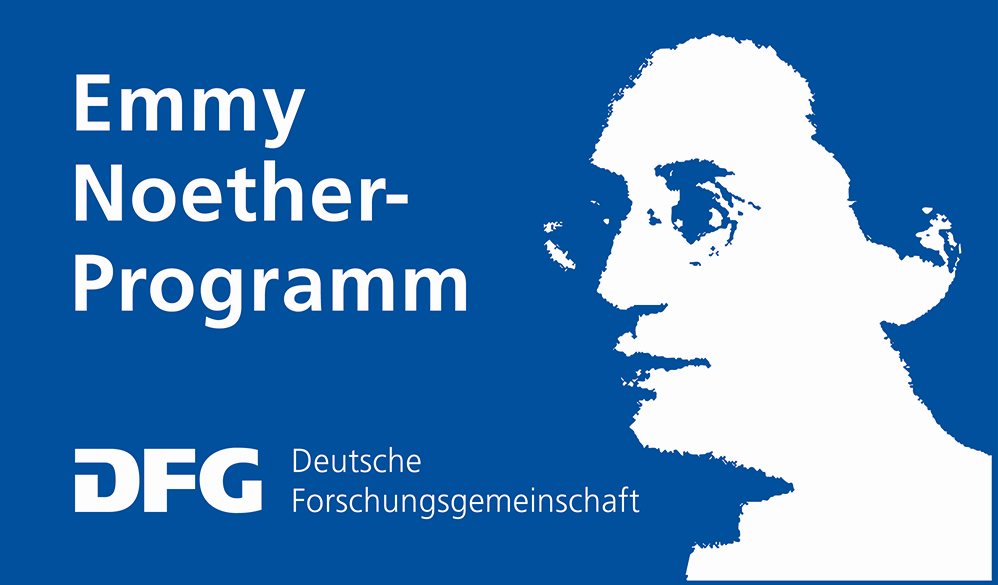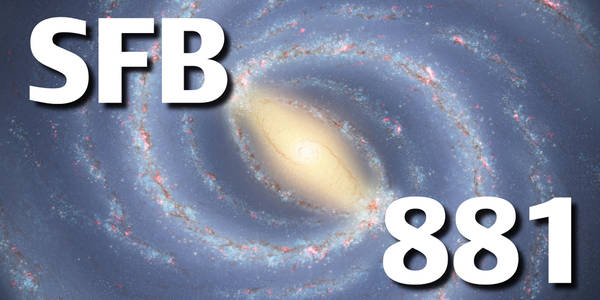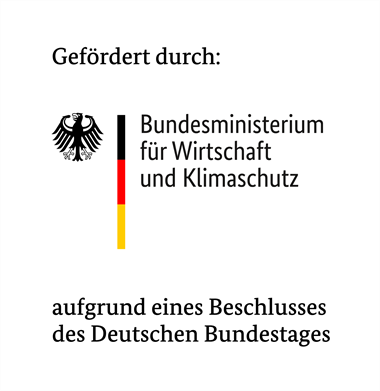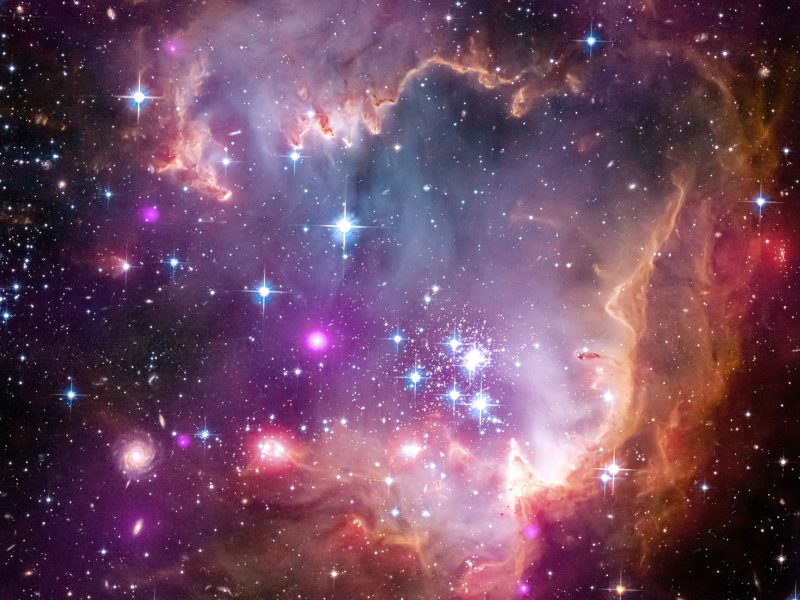
Analyzing Massive Stars
For most stars, light is the only piece of information available. By dispersing their light into a spectrum, we can learn more about the properties and the status of the stars.
A profound interpretation of the spectra for hot and massive stars is particularly challenging. The extreme conditions and the strong winds make common and handy techniques inapplicable. One example is that we use the concept of a `Local Thermodynamic Equilibrium` in their outer layers, exactly where the spectrum of a star is formed. Instead, complex numerical models are necessary to simulate the so-called ‘stellar atmosphere’ and understand the formation of the emergent spectrum.
By comparing synthetic spectra from stellar atmospheres to observations, we deduce the fundamental parameters of the highly influential class of hot stars, ranging from basic parameters such as their temperature, over their chemical composition to the strength of their wind and their ionizing flux.
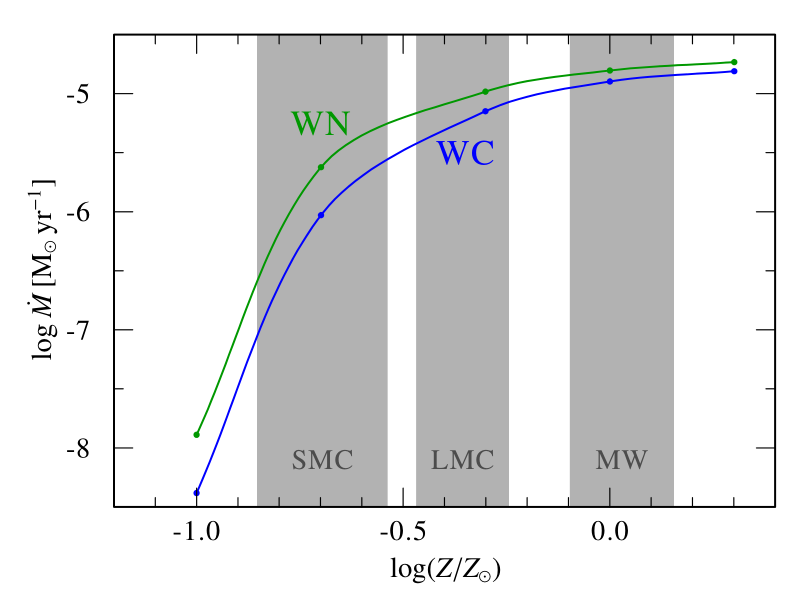
Predicting Stellar Feedback
The interplay between radiation and matter is one of the fundamental processes in astrophysics. With mass-loss rates a billion times stronger than our sun, hot and massive stars dominate not only their immediate surrounding, but can influence whole clusters and drive the chemical evolution of their host galaxy.
Given their key role, the proper treatment of ionizing and mechanical feedback of hot and massive stars is of major importance on all astrophysical scales. Unfortunately, providing robust predictions has turned out to be a difficult task over the past decades and existing recipes are flawed by often being limited to narrow parameter regimes. From the interpretation of ionizing fluxes to the mass spectrum of black holes, a range of major astrophysical problems is inherently tied to the uncertainties in the underlying feedback prescriptions and stellar evolution models.
Next-generation stellar atmospheres that include hydrodynamics are a key tool in overcoming present limitations as they are able to obtain predictions and unique insights into stellar feedback at any metallicity, where currently no robust description is available.
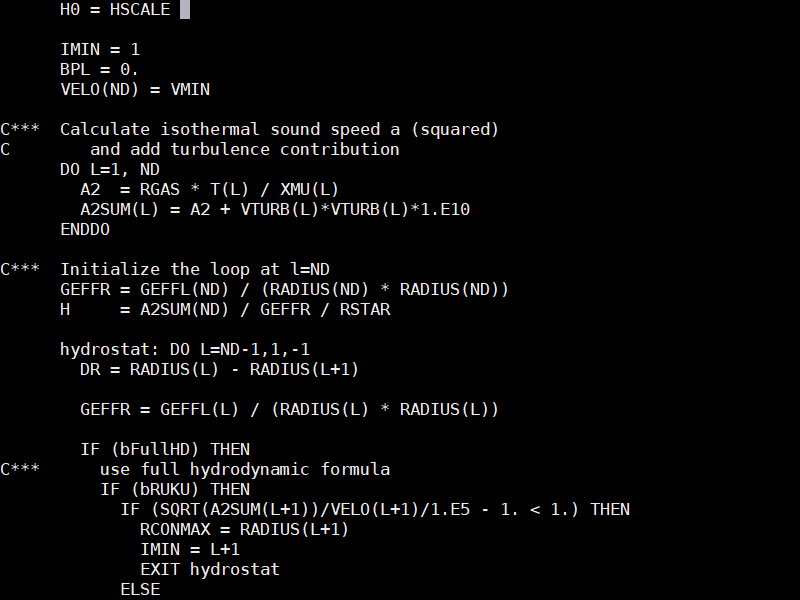
Developing Stellar Atmospheres
As outlined above with their vital role for analyses and predictions, stellar atmospheres are a fundamental ingredient in order to interpret observations and derive fundamental insights into how stars interact with their environment. While the first model efforts go back to a time where computer code was written on punched cards, the field of developing stellar atmospheres is far from being complete. While modern computers help to decrease computation times for simple models, high-resolution spectra and multi-wavelength astronomy provide a constant demand for a more detailed treatment, increasing the computational effort.
Essentially a laboratory for astrophysics, a stellar atmosphere code must constantly be maintained, improved and extended. This does not only include additional physics and performance improvements, but also the documentation and accessibility to the user. As an active developer of PoWR, it is one of my personal aims to supply the community with a tool that is powerful, but also easy enough to handle despite all the necessary complexity when combining all the different physics and numerics. This effort will help to pave the way to properly interpret observations with next-generation telescopes and reach theoretical breakthroughs in understanding stellar winds across cosmic times.
Recent Group Publications
- X-Shooting ULLYSES: Massive Stars at low metallicity -- IV. Spectral analysis methods and exemplary results for O stars
Sander, A. A. C., Bouret, J. -C., Bernini-Peron, M., Puls, J., Backs, F., Berlanas, S. R., Bestenlehner, J. M., Brands, S. A., Herrero, A., Martins, F., Maryeva, O., Pauli, D., Ramachandran, V., Crowther, P. A., Gómez-González, V. M. A., Gormaz-Matamala, A. C., Hamann, W. -R., Hillier, D. J., Kuiper, R., Larkin, C. J. K., Lefever, R. R., Mehner, A., Najarro, F., Oskinova, L. M., Schösser, E. C., Shenar, T., Todt, H., ud-Doula, A. and Vink, J. S.
arXiv preprint (07/2024) - Hydrodynamic simulation of Cygnus OB2: the absence of a cluster wind termination shock
Vieu, T., Larkin, C. J. K., Härer, L., Reville, B., Sander, A. A. C. and Ramachandran, V.
MNRAS, in press (07/2024) - Peering into the Wolf-Rayet phenomenon through [WO] and [WC] stars
Toalá, Jesús A., Todt, Helge and Sander, Andreas A. C.
MNRAS 531, 2422 (06/2024) - X-Shooting ULLYSES: Massive Stars at low metallicity VIII. Stellar and wind parameters of newly revealed stripped stars in Be binaries
Ramachandran, V., Sander, A. A. C., Pauli, D., Klencki, J., Backs, F., Tramper, F., Bernini-Peron, M., Crowther, P., Hamann, W. -R., Ignace, R., Kuiper, R., Oey, S., Oskinova, L. M., Shenar, T., Todt, H., Vink, J. S., Wang, L., Wofford, A. and the XShootU collaboration
arXiv preprint (06/2024) - X-Shooting ULLYSES: Massive stars at low metallicity -- V. Effect of metallicity on surface abundances of O stars
Martins, F., Bouret, J. -C., Hillier, D. J., Brands, S. A., Crowther, P. A., Herrero, A., Najarro, F., Pauli, D., Puls, J., Ramachandran, V., Sander, A. A. C., Vink, J. S. and the XshootU collaboration
arXiv preprint (05/2024) - Chemical abundances and ionizing mechanisms in the star-forming double-ring of AM 0644-741 using MUSE data
Gómez-González, V. M. A., Mayya, Y. D., Zaragoza-Cardiel, J., Bruzual, G., Charlot, S., Ramos-Larios, G., Oskinova, L. M., Sander, A. A. C. and Serantes, S. Reyero
MNRAS 529, 4369 (04/2024) - Impact of main-sequence mass loss on the appearance, structure and evolution of Wolf-Rayet stars
Josiek, Joris, Ekström, Sylvia and Sander, Andreas A. C.
arXiv preprint (04/2024) - X-Shooting ULLYSES: Massive Stars at Low Metallicity
Vink, J. S., Crowther, P., Fullerton, A., Garcia, M., Martins, F., Morrell, N., Oskinova, L., St Louis, N., ud-Doula, A., Sander, A., Sana, H., Bouret, J. -C., Kubatova, B., Marchant, P., Martins, L. P., Wofford, A., van Loon, J., Telford, O. G., Götberg, Y., Bowman, D., Erba, C., Kalari, V. and XShootU Collaboration
Msngr 192, 16 (03/2024) - M5 - Mars Magnetospheric Multipoint Measurement Mission: A multi-spacecraft plasma physics mission to Mars
Larkin, Cormac J. K., Lundén, Ville, Schulz, Leonard, Baumgartner-Steinleitner, Markus, Brekkum, Marianne, Cegla, Adam, Dazzi, Pietro, Iuliis, Alessia De, Gesch, Jonas, Lennerstrand, Sofia, Nesbit-Östman, Sara, Pires, Vasco D. C., Palanca, Inés Terraza, Teubenbacher, Daniel, Enengl, Florine and Hallmann, Marcus
AdSpR 73, 3235 (03/2024) - The effect of winds on atmospheric layers of red supergiants II. Modelling VLTI/GRAVITY and MATISSE observations of AH Sco, KW Sgr, V602 Car, CK Car, and V460 Car
González-Torà, G., Wittkowski, M., Davies, B. and Plez, B.
A&A 683, A19 (03/2024) - Aperture and Resolution Effects on Ultraviolet Star-forming Properties: Insights from Local Galaxies and Implications for High-redshift Observations
Clark, Ilyse, Berg, Danielle A., Leitherer, Claus, Arellano-Córdova, Karla Z. and Sander, Andreas A. C.
ApJ 964, 25 (03/2024) - The Wide-field Spectroscopic Telescope (WST) Science White Paper
Mainieri, Vincenzo, Anderson, Richard I., Brinchmann, Jarle, Cimatti, Andrea, Ellis, Richard S., Hill, Vanessa, Kneib, Jean-Paul, McLeod, Anna F., Opitom, Cyrielle, Roth, Martin M., Sanchez-Saez, Paula, Smiljanic, Rodolfo, Tolstoy, Eline, Bacon, Roland, Randich, Sofia, Adamo, Angela, Annibali, Francesca, Arevalo, Patricia, Audard, Marc, Barsanti, Stefania, Battaglia, Giuseppina, Bayo Aran, Amelia M., Belfiore, Francesco, Bellazzini, Michele, Bellini, Emilio, Beltran, Maria Teresa, Berni, Leda, Bianchi, Simone, Biazzo, Katia, Bisero, Sofia, Bisogni, Susanna, Bland-Hawthorn, Joss, Blondin, Stephane, Bodensteiner, Julia, Boffin, Henri M. J., Bonito, Rosaria, Bono, Giuseppe, Bouche, Nicolas F., Bowman, Dominic, Braga, Vittorio F., Bragaglia, Angela, Branchesi, Marica, Brucalassi, Anna, Bryant, Julia J., Bryson, Ian, Busa, Innocenza, Camera, Stefano, Carbone, Carmelita, Casali, Giada, Casali, Mark, Casasola, Viviana, Castro, Norberto, Catelan, Marcio, Cavallo, Lorenzo, Chiappini, Cristina, Cioni, Maria-Rosa, Colless, Matthew, Colzi, Laura, Contarini, Sofia, Couch, Warrick, D'Ammando, Filippo, d'Assignies D., William, D'Orazi, Valentina, da Silva, Ronaldo, Dainotti, Maria Giovanna, Damiani, Francesco, Danielski, Camilla, De Cia, Annalisa, de Jong, Roelof S., Dhawan, Suhail, Dierickx, Philippe, Driver, Simon P., Dupletsa, Ulyana, Escoffier, Stephanie, Escorza, Ana, Fabrizio, Michele, Fiorentino, Giuliana, Fontana, Adriano, Fontani, Francesco, Forero Sanchez, Daniel, Franois, Patrick, Galindo-Guil, Francisco Jose, Gallazzi, Anna Rita, Galli, Daniele, Garcia, Miriam, Garcia-Rojas, Jorge, Garilli, Bianca, Grand, Robert, Guarcello, Mario Giuseppe, Hazra, Nandini, Helmi, Amina, Herrero, Artemio, Iglesias, Daniela, Ilic, Dragana, Irsic, Vid, Ivanov, Valentin D., Izzo, Luca, Jablonka, Pascale, Joachimi, Benjamin, Kakkad, Darshan, Kamann, Sebastian, Koposov, Sergey, Kordopatis, Georges, Kovacevic, Andjelka B., Kraljic, Katarina, Kuncarayakti, Hanindyo, Kwon, Yuna, La Forgia, Fiorangela, Lahav, Ofer, Laigle, Clotilde, Lazzarin, Monica, Leaman, Ryan, Leclercq, Floriane, Lee, Khee-Gan, Lee, David, Lehnert, Matt D., Lira, Paulina, Loffredo, Eleonora, Lucatello, Sara, Magrini, Laura, Maguire, Kate, Mahler, Guillaume, Zahra Majidi, Fatemeh, Malavasi, Nicola, Mannucci, Filippo, Marconi, Marcella, Martin, Nicolas, Marulli, Federico, Massari, Davide, Matsuno, Tadafumi, Mattheee, Jorryt, McGee, Sean, Merc, Jaroslav, Merle, Thibault, Miglio, Andrea, Migliorini, Alessandra, Minchev, Ivan, Minniti, Dante, Miret-Roig, Nuria, Monreal Ibero, Ana, Montano, Federico, Montet, Ben T., Moresco, Michele, Moretti, Chiara, Moscardini, Lauro, Moya, Andres, Mueller, Oliver, Nanayakkara, Themiya, Nicholl, Matt, Nordlander, Thomas, Onori, Francesca, Padovani, Marco, Pala, Anna Francesca, Panda, Swayamtrupta, Pandey-Pommier, Mamta, Pasquini, Luca, Pawlak, Michal, Pessi, Priscila J., Pisani, Alice, Popovic, Lukav C., Prisinzano, Loredana, Raddi, Roberto, Rainer, Monica, Rebassa-Mansergas, Alberto, Richard, Johan, Rigault, Mickael, Rocher, Antoine, Romano, Donatella, Rosati, Piero, Sacco, Germano, Sanchez-Janssen, Ruben, Sander, Andreas A. C., Sanders, Jason L., Sargent, Mark, Sarpa, Elena, Schimd, Carlo, Schipani, Pietro, Sefusatti, Emiliano, Smith, Graham P., Spina, Lorenzo, Steinmetz, Matthias, Tacchella, Sandro, Tautvaisiene, Grazina, Theissen, Christopher, Thomas, Guillaume, Ting, Yuan-Sen, Travouillon, Tony, Tresse, Laurence, Trivedi, Oem, Tsantaki, Maria, Tsedrik, Maria, Urrutia, Tanya, Valenti, Elena, Van der Swaelmen, Mathieu, Van Eck, Sophie, Verdiani, Francesco, Verdier, Aurelien, Vergani, Susanna Diana, Verhamme, Anne, Vernet, Joel, Verza, Giovanni, Viel, Matteo, Vielzeuf, Pauline, Vietri, Giustina, Vink, Jorick S., Viscasillas Vazquez, Carlos, Wang, Hai-Feng, Weilbacher, Peter M., Wendt, Martin, Wright, Nicholas, Ye, Quanzhi, Yeche, Christophe, Yu, Jiaxi, Zafar, Tayyaba, Zibetti, Stefano, Ziegler, Bodo and Zinchenko, Igor
Whitepaper (03/2024) - A soft and transient ultraluminous X-ray source with six-hour modulation in the NGC 300 galaxy
Sacchi, A., Esposito, P., de Martino, D., Soria, R., Israel, G. L., Sander, A. A. C., Sidoli, L., Buckley, D. A. H., Monageng, I. M., Tiengo, A., Arca Sedda, M., Pinto, C., Di Stefano, R., Imbrogno, M., Carleo, A. and Rivolta, G.
A&A 682, A151 (02/2024) - X-Shooting ULLYSES: Massive Stars at low metallicity II. DR1: Advanced optical data products for the Magellanic Clouds
Sana, H., Tramper, F., Abdul-Masih, M., Blomme, R., Dsilva, K., Maravelias, G., Martins, L., Mehner, A., Wofford, A., Banyard, G., Barbosa, C. L., Bestenlehner, J., Hawcroft, C., Hillier, D. John, Todt, H., Larkin, C. J. K., Mahy, L., Najarro, F., Ramachandran, V., Ramirez-Tannus, M. C., Rubio-Diez, M. M., Sander, A. A. C., Shenar, T., Vink, J. S., Backs, F., Brands, S. A., Crowther, P., Decin, L., de Koter, A., Hamann, W. -R., Kehrig, C., Kuiper, R., Oskinova, L., Pauli, D., Sundqvist, J., Verhamme, O. and the XSHOOT-U collaboration
accepted for publication in A&A (02/2024) - Optically thick structure in early B-type supergiant stellar winds at low metallicities
Parsons, Timothy N., Prinja, Raman K., Bernini-Peron, Matheus, Fullerton, Alex W., Massa, Derck L., Oskinova, Lidia M., Pauli, Daniel, Rickard, Matthew J. and Sander, Andreas A. C.
MNRAS 527, 11422 (02/2024) - Constraints on the multiplicity of the most massive stars known: R136 a1, a2, a3, and c
Shenar, T., Sana, H., Crowther, P. A., Bostroem, K. A., Mahy, L., Najarro, F., Oskinova, L. and Sander, A. A. C.
A&A 679, A36 (11/2023) - Improving Undergraduate Astronomy Students' Skills with Research Literature via Accessible Summaries: A Case Study with Astrobites-based Lesson Plans
Lewis, Briley L., Waggoner, Abygail R., Clarke, Emma, Crisp, Alison L., Dodici, Mark, Doskoch, Graham M., Foley, Michael M., Golant, Ryan, Gozman, Katya, Hegde, Sahil, Huston, Macy J., Law, Charles J., Lefever, Roel R., Mishra, Ishan, Popinchalk, Mark, Sagynbayeva, Sabina, Yan, Wei, Ingraham Dixie, Kaitlin L. and Supriya, K.
submitted to the Journal of Science Education and Technology (JSET) (09/2023) - Very massive stars and pair-instability supernovae: mass-loss framework for low metallicity
Sabhahit, Gautham N., Vink, Jorick S., Sander, Andreas A. C. and Higgins, Erin R.
MNRAS 524, 1529 (09/2023) - Clumping and X-rays in cooler B supergiant stars
Bernini-Peron, M., Marcolino, W. L. F., Sander, A. A. C., Bouret, J. -C., Ramachandran, V., Saling, J., Schneider, F. R. N., Oskinova, L. M. and Najarro, F.
A&A 677, A50 (09/2023) - X-Shooting ULLYSES: Massive stars at low metallicity. I. Project description
Vink, Jorick S., Mehner, A., Crowther, P. A., Fullerton, A., Garcia, M., Martins, F., Morrell, N., Oskinova, L. M., St-Louis, N., ud-Doula, A., Sander, A. A. C., Sana, H., Bouret, J. -C., Kubátová, B., Marchant, P., Martins, L. P., Wofford, A., van Loon, J. Th., Grace Telford, O., Götberg, Y., Bowman, D. M., Erba, C., Kalari, V. M., Abdul-Masih, M., Alkousa, T., Backs, F., Barbosa, C. L., Berlanas, S. R., Bernini-Peron, M., Bestenlehner, J. M., Blomme, R., Bodensteiner, J., Brands, S. A., Evans, C. J., David-Uraz, A., Driessen, F. A., Dsilva, K., Geen, S., Gómez-González, V. M. A., Grassitelli, L., Hamann, W. -R., Hawcroft, C., Herrero, A., Higgins, E. R., John Hillier, D., Ignace, R., Istrate, A. G., Kaper, L., Kee, N. D., Kehrig, C., Keszthelyi, Z., Klencki, J., de Koter, A., Kuiper, R., Laplace, E., Larkin, C. J. K., Lefever, R. R., Leitherer, C., Lennon, D. J., Mahy, L., Maíz Apellániz, J., Maravelias, G., Marcolino, W., McLeod, A. F., de Mink, S. E., Najarro, F., Oey, M. S., Parsons, T. N., Pauli, D., Pedersen, M. G., Prinja, R. K., Ramachandran, V., Ramírez-Tannus, M. C., Sabhahit, G. N., Schootemeijer, A., Reyero Serantes, S., Shenar, T., Stringfellow, G. S., Sudnik, N., Tramper, F. and Wang, L.
A&A 675, A154 (07/2023) - From Dust to Nanodust: Resolving Circumstellar Dust from the Colliding-wind Binary Wolf-Rayet 140
Lau, Ryan M., Wang, Jason, Hankins, Matthew J., Currie, Thayne, Deo, Vincent, Endo, Izumi, Guyon, Olivier, Han, Yinuo, Jones, Anthony P., Jovanovic, Nemanja, Lozi, Julien, Moffat, Anthony F. J., Onaka, Takashi, Ruane, Garreth, Sander, Andreas A. C., Tinyanont, Samaporn, Tuthill, Peter G., Weigelt, Gerd, Williams, Peredur M. and Vievard, Sebastien
ApJ 951, 89 (07/2023) - A partially stripped massive star in a Be binary at low metallicity. A missing link towards Be X-ray binaries and double neutron star mergers
Ramachandran, V., Klencki, J., Sander, A. A. C., Pauli, D., Shenar, T., Oskinova, L. M. and Hamann, W. -R.
A&A 674, L12 (06/2023) - Exploring the influence of different velocity fields on Wolf-Rayet star spectra
Lefever, R. R., Sander, A. A. C., Shenar, T., Poniatowski, L. G., Dsilva, K. and Todt, H.
MNRAS 521, 1374 (05/2023) - Spectroscopic and evolutionary analyses of the binary system AzV 14 outline paths toward the WR stage at low metallicity
Pauli, D., Oskinova, L. M., Hamann, W. -R., Bowman, D. M., Todt, H., Shenar, T., Sander, A. A. C., Erba, C., Gómez-González, V. M. A., Kehrig, C., Klencki, J., Kuiper, R., Mehner, A., de Mink, S. E., Oey, M. S., Ramachandran, V., Schootemeijer, A., Reyero Serantes, S. and Wofford, A.
A&A 673, A40 (05/2023) - Misidentification of Short GRBs as Magnetars in Nearby Galaxies
Schösser, E. C., Burgess, J. M. and Greiner, J.
arXiv preprint (03/2023) - Looking for nebular He II emission south of the multiple-massive star system, HD 5980
Sixtos, A., Wofford, A., Sander, A. A. C. and Peimbert, A.
MNRAS 519, 5656 (03/2023) - X-Shooting ULLYSES: Massive stars at low metallicity. III. Terminal wind speeds of ULLYSES massive stars
Hawcroft, C., Sana, H., Mahy, L., Sundqvist, J. O., de Koter, A., Crowther, P. A., Bestenlehner, J. M., Brands, S. A., David-Uraz, A., Decin, L., Erba, C., Garcia, M., Hamann, W. -R., Herrero, A., Ignace, R., Kee, N. D., Kubátová, B., Lefever, R., Moffat, A., Najarro, F., Oskinova, L., Pauli, D., Prinja, R., Puls, J., Sander, A. A. C., Shenar, T., St-Louis, N., ud-Doula, A. and Vink, J. S.
accepted for publication in A&A (03/2023) - The temperature dependency of Wolf-Rayet-type mass loss. An exploratory study for winds launched by the hot iron bump
Sander, A. A. C., Lefever, R. R., Poniatowski, L. G., Ramachandran, V., Sabhahit, G. N. and Vink, J. S.
A&A 670, A83 (02/2023) - Bringing Stellar Evolution and Feedback Together: Summary of Proposals from the Lorentz Center Workshop
Geen, Sam, Agrawal, Poojan, Crowther, Paul A., Keller, B. W., de Koter, Alex, Keszthelyi, Zsolt, van de Voort, Freeke, Ali, Ahmad A., Backs, Frank, Bonne, Lars, Brugaletta, Vittoria, Derkink, Annelotte, Ekström, Sylvia, Fichtner, Yvonne A., Grassitelli, Luca, Götberg, Ylva, Higgins, Erin R., Laplace, Eva, You Liow, Kong, Lorenzo, Marta, McLeod, Anna F., Meynet, Georges, Newsome, Megan, André Oliva, G., Ramachandran, Varsha, Rey, Martin P., Rieder, Steven, Romano-Díaz, Emilio, Sabhahit, Gautham, Sander, Andreas A. C., Sarwar, Rafia, Stinshoff, Hanno, Stoop, Mitchel, Szécsi, Dorottya, Trebitsch, Maxime, Vink, Jorick S. and Winch, Ethan
PASP 135, 021001 (02/2023) - Winds of OB stars: impact of metallicity, rotation and binary interaction
Ramachandran, Varsha
IAUS 370, 223 (12/2022) - The Driving of Hot Star Winds
Sander, Andreas A. C.
IAUS 370, 130 (12/2022) - Massive Stars in the Far and Extreme Ultraviolet
Sander, Andreas A. C.
Proceedings of the IAU General Assembly 2022 (Astronomy in Focus, Focus Meeting 4) (11/2022) - Massive star feedback in the Magellanic Clouds and the tidal Bridge
Ramachandran, Varsha
Proceedings of the IAU General Assembly 2022 (Astronomy in Focus, Focus Meeting 4) (11/2022) - Phase-resolved spectroscopic analysis of the eclipsing black hole X-ray binary M33 X-7: System properties, accretion, and evolution
Ramachandran, V., Oskinova, L. M., Hamann, W. -R., Sander, A. A. C., Todt, H., Pauli, D., Shenar, T., Torrejón, J. M., Postnov, K. A., Blondin, J. M., Bozzo, E., Hainich, R. and Massa, D.
A&A 667, A77 (11/2022) - The hydrogen clock to infer the upper stellar mass
Higgins, Erin R., Vink, Jorick S., Sabhahit, Gautham N. and Sander, Andreas A. C.
MNRAS 516, 4052 (11/2022) - Stellar wind properties of the nearly complete sample of O stars in the low metallicity young star cluster NGC 346 in the SMC galaxy
Rickard, M. J., Hainich, R., Hamann, W. -R., Oskinova, L. M., Prinja, R. K., Ramachandran, V., Pauli, D., Todt, H., Sander, A. A. C., Shenar, T., Chu, Y. -H. and Gallagher, J. S.
A&A 666, A189 (10/2022) - Investigating the impact of different velocity fields on the spectral appearance of Wolf-Rayet stars
Lefever, Roel R., Shenar, Tomer, Sander, Andreas A. C., Poniatowski, Luka, Dsilva, Karan and Todt, Helge
Proceedings of the IAUS 361: Massive Stars Near and Far (09/2022) - The enigmatic winds of Wolf-Rayet stars: Results from dynamically consistent atmosphere modelling
Sander, Andreas A. C.
Proceedings of the IAUS 361: Massive Stars Near and Far (09/2022) - Mass-loss implementation and temperature evolution of very massive stars
Sabhahit, Gautham N., Vink, Jorick S., Higgins, Erin R. and Sander, Andreas A. C.
MNRAS 514, 3736 (08/2022) - Ionization and Star Formation in the Giant H II Region SMC-N66
Geist, E., Gallagher, J. S., Kotulla, R., Oskinova, L., Hamann, W. -R., Ramachandran, V., Sabbi, E., Smith, L., Kniazev, A., Nota, A. and Rickard, M. J.
PASP 134, 064301 (06/2022) - Wind properties of Milky Way and SMC massive stars: empirical Z dependence from CMFGEN models
Marcolino, W. L. F., Bouret, J. -C., Rocha-Pinto, H. J., Bernini-Peron, M. and Vink, J. S.
MNRAS 511, 5104 (04/2022) - The earliest O-type eclipsing binary in the Small Magellanic Cloud, AzV 476: A comprehensive analysis reveals surprisingly low stellar masses
Pauli, D., Oskinova, L. M., Hamann, W. -R., Ramachandran, V., Todt, H., Sander, A. A. C., Shenar, T., Rickard, M., Maíz Apellániz, J. and Prinja, R.
A&A 659, A9 (03/2022) - The Link between Hot and Cool Outflows
Vink, Jorick S., Sander, A. A. C., Higgins, E. R. and Sabhahit, G. N.
IAUS 366, 96 (12/2021) - The origin and impact of Wolf-Rayet-type mass loss
Sander, Andreas A. C., Vink, Jorick S., Higgins, Erin R., Shenar, Tomer, Hamann, Wolf-Rainer and Todt, Helge
IAUS 366, 21 (12/2021) - Superadiabaticity and the metallicity independence of the Humphreys-Davidson limit
Sabhahit, Gautham N., Vink, Jorick S., Higgins, Erin R. and Sander, Andreas A. C.
MNRAS 506, 4473 (09/2021)
Reviews and Outreach Publications
- Vom Winde verweht: Die Winde heißer Sterne verändern kosmische Strukturen und unser Bild vom Leben massereicher Sterne
Andreas A.C. Sander
Physik Journal, Mai 2022, S28ff (05/2022)

